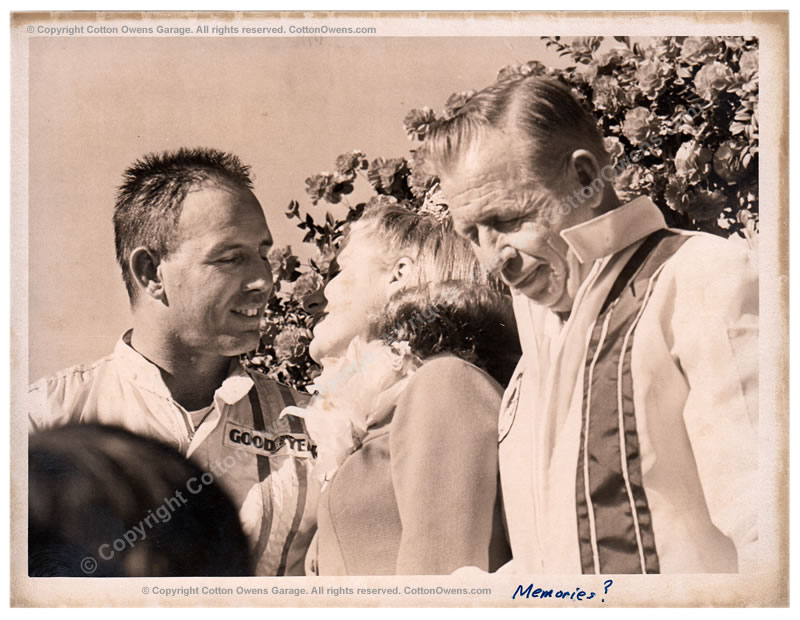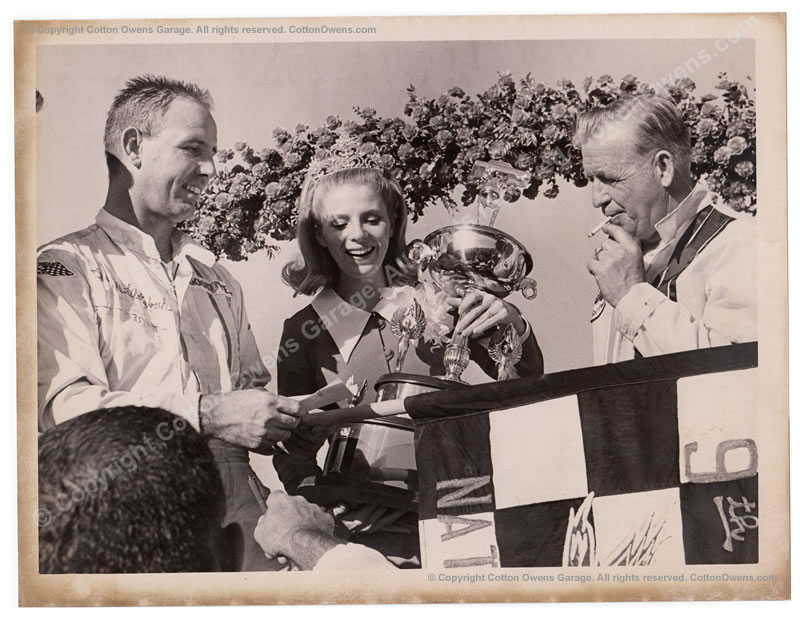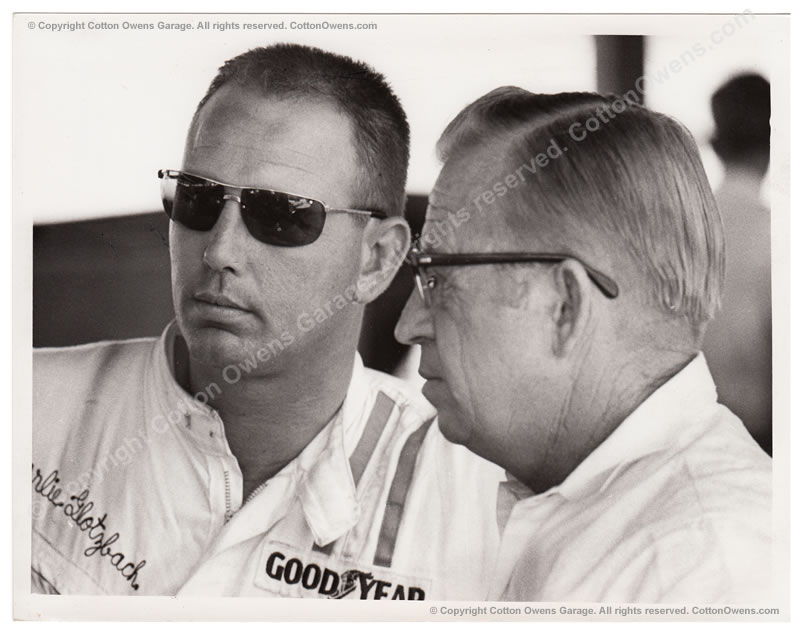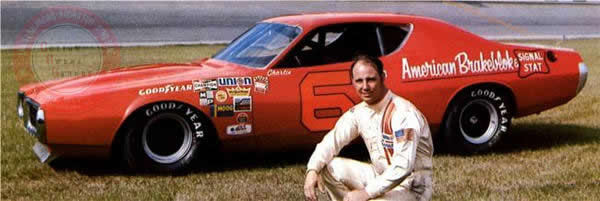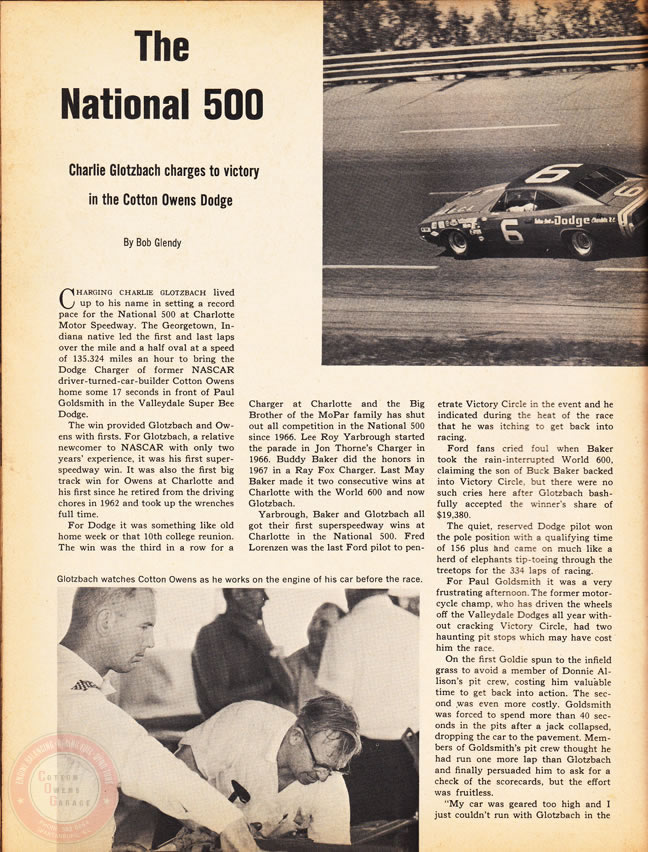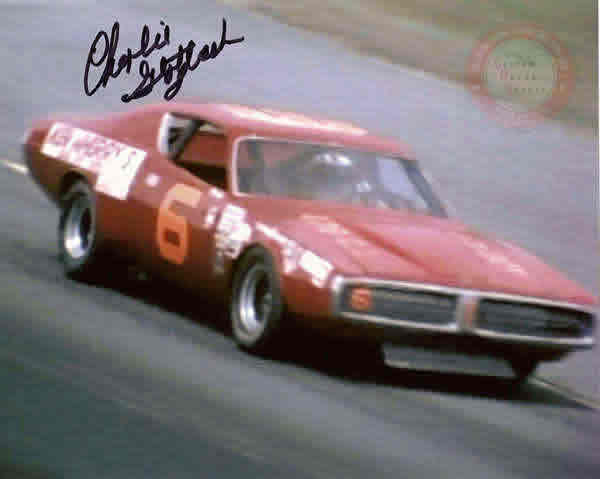Drivers
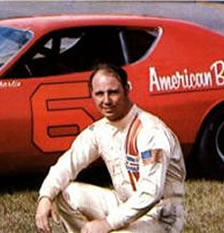 "Chargin'" Charlie Glotzbach
Born: June 19, 1938
"Chargin'" Charlie Glotzbach
Born: June 19, 1938
Hometown: Edwardsville, IN
Driver for Cotton Owens Garage: 1968-1972
Performance in COG cars:
Races: 28
Wins: 1
Top 5: 14
Top 10: 16
Poles: 3
View Charlie Glotzbach's career NASCAR driving statistics
Watch Chargin' Charlie go for a spin!
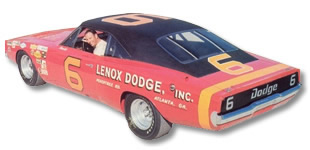 A Real Charger
A Real Charger
"He was a charger," said three-time Indianapolis 500 winner Johnny Rutherford. "That's how he got his name," said four-time Indy 500 winner A.J. Foyt. "He stood on the gas."
Glotzbach drove in 124 NASCAR races and, remarkably, finished in the top 10 in 50 of them. His record includes 12 pole positions and four victories. Eight times he placed second, and he also had five thirds, 18 fourths and three fifths.
His first NASCAR Winston Cup race was in 1960. While never running a full Winston Cup schedule, he ran a partial schedule every year from 1967 to 1975. The most he ran in a single year was in 1968, when he raced in 22 of 48 events. In 1969 he finished second in the Daytona 500 after being passed on the last lap by LeeRoy Yarbrough.
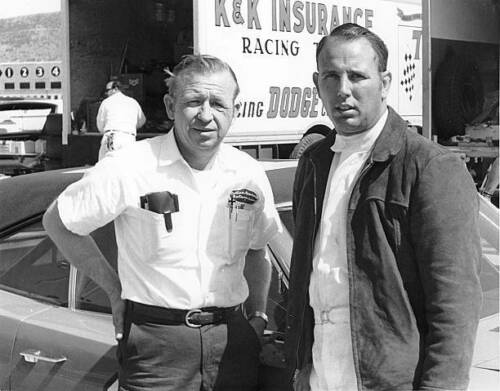 Glotzbach piloted his Cotton Owens Dodge to victory at the 1968 National 500 at Charlotte. They also lost the Daytona 500 of 1969 by a mere .01 of a second to Ford-Mercury king LeeRoy Yarborough. After the Atlanta 500-miler in March, 1969, Glotzbach became fed up with NASCAR rules and quit, which opened the door for Buddy Baker to join up with Owens.
Glotzbach piloted his Cotton Owens Dodge to victory at the 1968 National 500 at Charlotte. They also lost the Daytona 500 of 1969 by a mere .01 of a second to Ford-Mercury king LeeRoy Yarborough. After the Atlanta 500-miler in March, 1969, Glotzbach became fed up with NASCAR rules and quit, which opened the door for Buddy Baker to join up with Owens.
In late 1969, Glotzbach received broken ribs and was shot twice during an altercation with a former employee of his race team, Nichols Engineering. He returned the next season and continued to run competitively with one of the bullets still in his shoulder. (ABC Wide World of Sports Broadcast, 1970 Daytona 500.)
Glotzbach set a World Record of 199.466 mph in September 1969 at Talladega, driving the Chrysler Engineering #88 Dodge Charger Daytona. The car was the pole winner, but Glotzbach, along with most other drivers, sat out the race due to a tire boycott.
His last NASCAR Winston Cup race was in 1992, a season when he competed in seven events. He has four wins and 12 poles in NASCAR.
NASCAR Grand National (Cup) Career Wins Summary
| Win # |
Date |
Race
|
Track |
| 1 |
10.20.1968 |
- |
Charlotte |
| 2 |
2.19.1970 |
Daytona 125 (qualifier) |
Daytona |
| 3 |
8.16.1970 |
Yankee 400 |
Michigan |
| 4 |
7.11.1971 |
Bristol |
Bristol |
NASCAR Career Poles Summary
(12 Pole Awards - incomplete listing)
| Win # |
Date |
Race |
Track |
| 1 |
October 26, 1969 |
American 500 |
Rockingham |
| 2 |
May 9, 1970 |
Rebel 400 |
Darlington |
| 3 |
August 16, 1970 |
Yankee 400 |
Michigan |
| 4 |
October 11, 1970 |
National 500 |
Charlotte |
| 5 |
October 15, 1970 |
American 500 |
Rockingham |
NASCAR Career Track Summary
| Track |
Poles |
Wins |
| Bristol |
0 |
1 |
| Charlotte |
1 |
1 |
| Darlington |
1 |
0 |
| Daytona |
0 |
1 |
| Michigan |
0 |
1 |
| Rockingham |
1 |
0 |
A Lap Down Memory Lane with Charlie Glotzbach
By Matt Boyd, Die Cast X Magazine, 2017
Charlie was one of Dodge's top NASCAR drivers during the late '60s and early '70s, and was the primary test and driver during the development of the winged Dodge Charger Daytona for Chrysler during the 1969 season. As part of our "NASCAR's Aero Warriors" feature in the Summer issue of Die Cast X (now on sale) I got a chance to speak with Charlie about his experiences developing the winged Dodge, his role in one of the most exciting and influential finishes in Daytona history, and his thoughts about the state of NASCAR racing in 2017. What follows is the extended version of our conversation. — Matt Boyd
Die Cast X: After the Dodge engineers saw that the Charger 500 wasn't quite up to scratch against the Fords, you personally did most of the testing for the development of the Daytona, isn't that correct?
Charlie Glotzbach: Yeah, I did the wing car. On the Charger 500, I mean all they done there was put a flush back window in that car. That's the one I ran second in Daytona. They started developing the wing Dodge after that, and we done a lot of testing on that thing at the Chrysler proving grounds. I'd go up there on Saturday or when we wasn't racing that weekend and do the testing there. And we tested at Talladega and Daytona—we tested about every race track around, developing that car. There was no comparison [between the Charger 500] and the wing car. I mean the wing car was absolutely perfect. I mean it really was. I never will forget Larry Rathgeb, he was the engineer on the thing and we was at Talladega testing. He said, "Now, if that thing gets a little loose with ya, just turn loose the steering wheel and it'll straighten up." And so I actually tried it. It got a little loose one time and I didn't take my hands clean off, but I just opened my hands up and that thing did it—straightened itself right out.
DCX: The side supports on the wing were basically airplane rudders, weren't they?
CG: Right. Yup, that was, the up and down ones kept the car going straight and the cross one was adjustable and they could change the degrees, the angle of it, and give it more downforce in the back or take some off. We were running at about two degrees, or something like that, or one degree depending on what we were doing at Talladega or Daytona. Now on the shorter track they'd run a little more cause you weren't going as fast.
DCX: On the short tracks did it make a difference or did you really need to be moving before you could feel it?
CG: Nah, you could feel it. I mean, on the intermediate tracks you could feel it. I mean, it absolutely worked. Even on a short half-mile track, it worked.
DCX: I'm sure that the car felt much different with the nose cone and the wing on it. As the engineers were developing it, what were you guys were giving feedback about?
CG: Yeah. When we'd go out and run whatever laps they tell us, maybe ten laps or maybe twenty laps or even just two laps, you know. And then we'd give the feedback on whatever they was working on at that particular time. And they'd change something, maybe a torsion bar or a spring, because it took a different set up for them wing cars, they had a lot more downforce. We done lots and lots of development on that thing in the few months there.
DCX: Before the season started, did you guys know what Ford was up to with their Talladega—the drop nose cars that Holman and Moody were working on?
CG: Well, I think they all had spies. They'd have spies watching us and Chrysler had spies watching them. Especially if it went to a racetrack, they'd have someone setting up there somewhere with binoculars watching what was going on.
DCX: So, now with that situation going on and everybody was trying to one up everybody else with the aero cars and back and forth, was it an exciting time for you guys? Or was it scary? Was it a positive thing? Or were you just kind of thinking that it was too much?
CG: No, no, I loved it. I mean, and I liked to test. It was interesting just learning what done what. George Wallace—he was an engineer for Chrysler, not the governor—he would get in the car and ride with me. He would sit on the floorboard and wrap his arm around that "Petty bar"—they called it—and he'd sit there and ride 200 mile an hour sitting on the floorboard.
DCX: Well he had to trust your hands pretty well to be willing to ride around loose in the car.
CG: He sure did. But he did it all the time. Or you know, not every lap, but he'd get in it if he wanted. They'd tie little strings on the hood, and then they'd watch them to see what they done in the air and they'd learn stuff that way. And then they had some gauges over on the passenger's side there, and he'd sit and read them—see what done this and done that.
DCX: So, how many miles you think you did in testing? Or how many laps? Any idea?
CG: No, I don't have any idea. I mean, we ran thousands of miles at different tracks, you know. Talladega or Daytona—we'd probably run 500 miles in a couple days or something—it takes a lot of time when you're doing that cause they stop, change this and change that.
DCX: Now, I think I read that while you were testing at the Chelsea proving grounds you lapped that thing at something like 240 miles an hour?
CG: 243.
DCX: Wow! Now how big is that track?
CG: It was a five mile oval and there's no guard rail. They told me, they said you got to watch out 'cause there's a lot of deer in here. [laughter]. I mean, what are you going to do if a deer comes at you? There's no way you're going to keep from hitting it. Luckily I never hit nothing but a bird.
DCX: Well, that's lucky for you. Not quite as lucky for the bird.
CG: [laughter] That's for sure. Actually that was the car I sat on the pole with at Talladega. That car wasn't supposed to be raced.
DCX: That was the 88 car?
CG: Yes, sir. 88. And the 99, well they gave me my choice whichever one, they was both in Talladega.
DCX: But ultimately you guys didn't run that race. You qualified it on pole, but you chose not to run because of the tire situation, right?
CG: Yeah, some of us did. And then Brickhouse, he drove the 99 car—my car—the one I ran all the time. He ended up running it. And he won the race with it. But they wasn't running them as fast as they could go. They just put a show on with them, that's all they done.
DCX: They finished something like 6 or 7 laps ahead of everybody else?
CG: Yeah. And they just ran 180 mile an hour or something 'cause you couldn't run full laps with it running wide open 'cause it would tear the tires off it. They pranced! I mean it was just absolutely a fabulous race car.
DCX: Now was it just because Talladega was rougher, because it was a new track or was it that much faster?
CG: Yeah. Well, it was a lot faster, plus the compound—the asphalt—was real coarse, I think, and then it was rough too. In one and two, you couldn't hardly focus your eyes when you went in there it'd shake so bad.
DCX: Now, did they get better with the tires—did they have to up their game because you guys had done so much with the car?
CG: Well, Goodyear did. Yeah, they finally made a tire that would hold up. We never had tire trouble up till we went to Talladega for the race. We ran the tires in practice, but we never did run too much, you know, as far as trying to run any long runs.
DCX: Let me switch it up and ask you a little bit about the '69 Daytona race. I went back when I was working on this story and watched the footage of the race again and I noticed that going in to the last stop, you guys didn't change tires. And Yarbrough did. And you had a good lead on him, but he was coming fast. Do you think tires were the difference, or was it something else? It seemed like earlier in the race the cars were pretty equal, but then at the end he had the fresh tires. Is that what did it? Is that what caught you up?
CG: No, Buddy Baker did it. Buddy Baker got back a ways, he couldn't catch me but he was running just far enough there that he was holding me back and LeRoy, he was in front of him a ways. When a car does that, it slows that front car up.
DCX: So, he pulled the draft off of you and gave it to LeRoy?
CG: Right. And that's what cost me the race, was Buddy Baker.
M: Now, did he do it on purpose? Because you guys were kinda like teammates, weren't you?
CG: Oh, I don't know. I have no idea if he done it on purpose, but he drove for Ray Fox, so no—we weren't really teammates. I mean we drove Dodges, but anyway. I like Buddy, but he did that and I don't know why he did it. But he did it and it's history.
#98 LeeRoy Yarbrough takes the checkered flag just ahead of #6 Charlie Glotzbach to win the 1969 Daytona 500. Yarbrough took a softer compound tire on his final stop and was able to run down Glotzbach and slingshot past him on the final lap to win the race.
No. 98 LeeRoy Yarbrough takes the checkered flag just ahead of Charlie to win the 1969 Daytona 500 after catching him on the last lap. (Photo courtesy of Smyle Media.)
DCX: Obviously you got involved with the wing car and then you won with it the following year, didn't you?
CG: In Michigan, yeah. Well, and I won the qualifying race at Daytona with it. And I was going to win the Daytona 500 but the left front wheel broke. Going through 3 and 4, it started shaking and I dove into the pits and they changed the tires and the left front wheel broke. So, they gassed me up and they had this idea, you know the back then they had this gas cap on with a cable on it. And they had this idea that they could have someone stand there with a gas cap in their hand and slap it on there and just leave the other one dangling. Well, NASCAR didn't think it had a cap on it and they black flagged me.
DCX: Oh no!
CG: So I think I ended up running fourth that time. But that's just things that happen, you know.
DCX: Especially with a race like that, it seems like it's luck as much as anything else. You know, even this past Sunday you watch who you thought was fastest and then the next thing you know there will be some ridiculous wreck! [Editor's note: Charlie and I spoke just a couple of days after the 2017 Daytona 500]
CG: It was a wreck fest, is all that was! The whole weekend was a wreck fest. I mean, that's ridiculous. You know, when we was racin' we didn't have but maybe five cautions—if that many. A lot of tracks we didn't have none. Like Bristol—I won that in Junior's [Junior Johnson] Chevrolet—which we still hold the record there for the race—and we never had a caution. For the whole race! And like I said, we didn't have 10 cars sittin' at the shop. We had two cars. We had long tracks—which was Daytona and such—and the intermediate track car. And then we had a short track—like half-mile cars.
DCX: And you guys ran some dirt tracks back then, didn't you?
CG: Yeah, I sure did. Now I didn't run all the races, but when I drove for Cotton [Owens] we run…well, actually the first track I run for Cotton when I went to work for him was Richmond, Virginia. And it was dirt then. And I run second up there.
DCX: I would think that the suspensions on the dirt track cars had to be completely different—even than the short track cars for asphalt—didn't they?
CG: Oh yeah. Back then they had trap doors and a cable running up to the bar there, and you could pull that and look at your right front tire, and right rear tire. They even had 'em on the big long tracks. You had to look back to see your right rear one, but the right front one you could just look to the right, open that door and see it.
DCX: And you could see enough even with it spinning like that to tell what was going on with it?
CG: Oh yeah. You could tell where you was at with 'em. They've come a long way on tires since then.
DCX: And in terms of aerodynamics too—the amount of money and time they spend polishing up the cars today and getting them so slick that they go through the air.
CG: Yeah—coil-binding and all that crap!
DCX: On restrictor plate tracks they've probably got 200 less horsepower then you guys did, and they're still turning about the same lap times.
CG: Oh yeah they choke 'em down, but see—we didn't start running restrictor plates until the winged Dodge. In fact, I won—I think—the first race with the restrictor plates. At Michigan. On that 99 car.
DCX: So they started with plates in '70, and then in '71 didn't they make you take the Hemi motors out and run a tiny little engine if you wanted to run the winged car?
CG: Yeah, a 305 motor, or something like that. I never run none of them. The race I won at Michigan we had a restrictor plate—well, I think they had rings in the intake manifold back then. Which is the same thing—getting the size of the hole down. NASCAR would check—they had a thing that when they took the carburetor off it had to fit tight down in that ring. It was the same thing as a restrictor plate but it was down in the manifold.
DCX: So now—unrestricted your car had what, 600 horsepower or thereabouts?
CG: Yeah, probably 650 or something like that.
DCX: And then when they put the restrictor on it, how much do you think it had then?
CG: I don't remember now what it was—but I think it was around 450 or something like that.
DCX: Now, when the Ford guys got their 429—
CG: Their Hemi! That was a Hemi!
DCX: Exactly. Now, I've read that they gained something like 40 or 50 horsepower from what the old 427s could run… Oh yeah.
DCX: So now they had the better aero and the better motor—until the Daytona came out. And then you guys caught 'em right back up and passed 'em.
CG: Yeah, that's right. That 429 was a heck of a motor. It was just built for racin' is all it was built for. The Hemi actually was a "stock" car motor. I mean a factory car. They actually raced them cars without doin' a whole bunch of different rods and cranks. It was all the stuff that they came out with in the street cars.
DCX: Everybody thinks about that era in terms of the wing cars and the battles that went on. And all the craziness: Richard Petty defecting over to Ford for a year—everybody sitting out Talladega because it was too fast for the tires. There was just a lot of drama going on that year. Was it the most fun era to be in NASCAR because of all that—from a driver's perspective? Fans love it—it's probably the most popular time period for NASCAR ever. How was it from a driver's perspective? Did you like it once it started to calm down, or was all that exciting to you?
CG: Oh it was exciting to me. I liked it! I liked experimentin' and that's what went on a lot. That's the reason I liked drivin' for Junior Johnson, because Junior would try anything!
DCX: There were a few guys back then—Smokey Yunick too. For them it seemed like that was part of the science of racing. See what you could figure out, see if you could be smarter than the next guy.
That's part of racing—yeah! That is racing. Now they took all that away. Racing today isn't racing. Not in my book anyway. It's like this blockin' they do—I mean, we never done that. If somebody got up to your door—you know—and they was faster—you didn't try and chop 'em off! You'd still keep racin' 'em, but if they could get by you let 'em go. Now, they wreck 'em! They tore up millions of dollars worth of stuff down there this past weekend [at the 2017 Daytona 500].
DCX: Well, they're all driving the same stuff so they go exactly the same speed, so they end up in a clump of 30 cars. And when something happens it wipes out half of them!
CG: What it actually is—they have no respect for eachother. We had respect for eachother. And these kids have no respect for nothin'! And we had real race cars! They was pretty much factory cars back them days. If they was unibody, then that's what they was. They didn't put a frame under 'em. It relates to what you're drivin'!
DCX: You identify with it as a fan, but you also admire the guy who's smart enough to figure out a way to make something work, and move the sport forward.
CG: You're right! See, that's the good thing about the Dodges and the Fords—back then they was experimentin' and actually makin' em better—that was racin'. Now they're all the same. And those were real race cars. Especially that winged Dodge. That was the best race car that ever hit the tracks. I'd hate to see one of them out there against the new ones today—with the tires and everything they got now, I'll guarantee you it'd blow 'em away!
DCX: I think you're probably right. You were lapping Talladega at basically the same speed these modern cars do today, and you didn't have the tires or any of the other modern advances that they do.
CG: We had treaded tires! And only about 6 inches wide I think. [laughs] I think back in '69-70 we run Daytona at about 193 mile an hour—somethin' like that—me and Cale [Yarborough] both was about the same speed. The Ford was runnin' about that, and the Dodge was too. And they're not runnin' much better'n that right today. They was just a fabulous racecar. I mean it's amazing the difference. Now to back then…back then was better. [chuckles.]
DCX: It's definitely the era the fans want to talk about. And the guys who are making the model cars—that's the era they want to make. And it's the era of models of cars fans want buy.
CG: The model cars they're making now are just amazing. So realistic! I mean, they're just exactly—exactly—like the racecars! Every little detail is just exactly—I looked 'em over. That no. 6 car they built of mine. You know, I was always around when they was workin' on them Chargers, and every little detail is just like it was. It's amazing! The Hemi motor—they got the breathers just exactly like they used to put on the no. 6 Dodge. Every detail about it is right. That winged Dodge would really be somethin'. I hope they're gonna be workin' on it here soon. It takes 'em about a year to get 'em out, and they say the molds can cost $100,000! I guess racing is expensive no matter where you do it! [laughs].


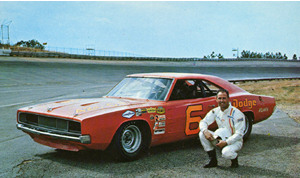
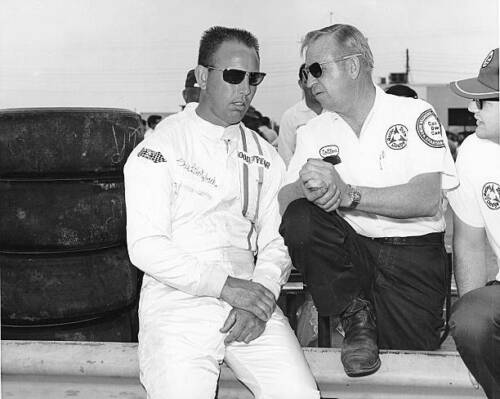
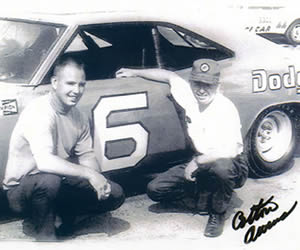


Click the magazine cover above to read the article
